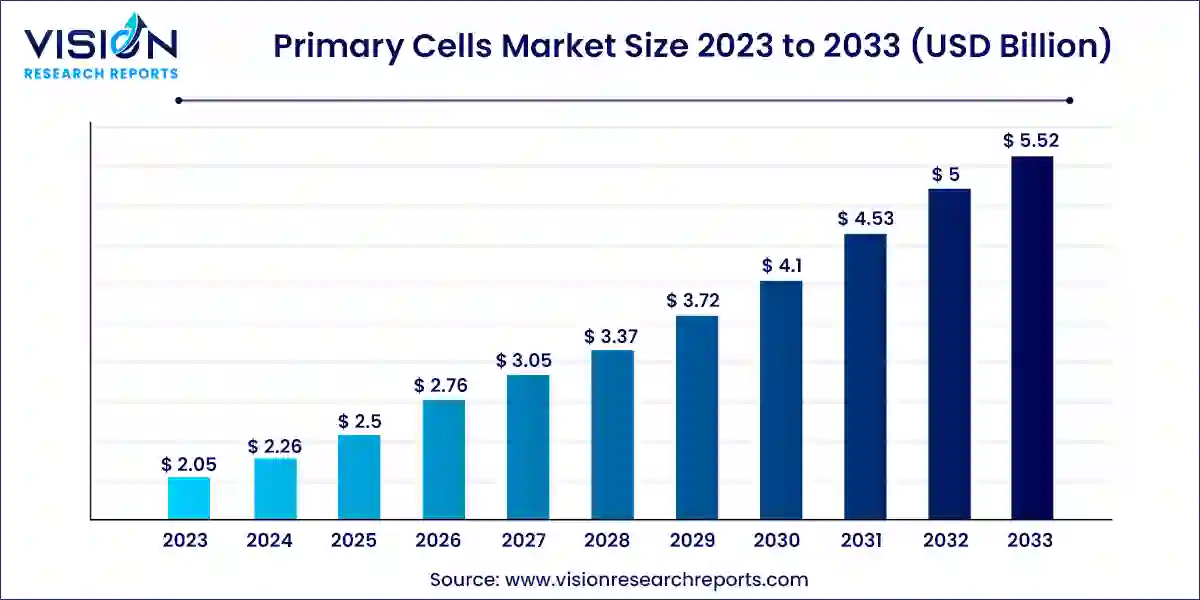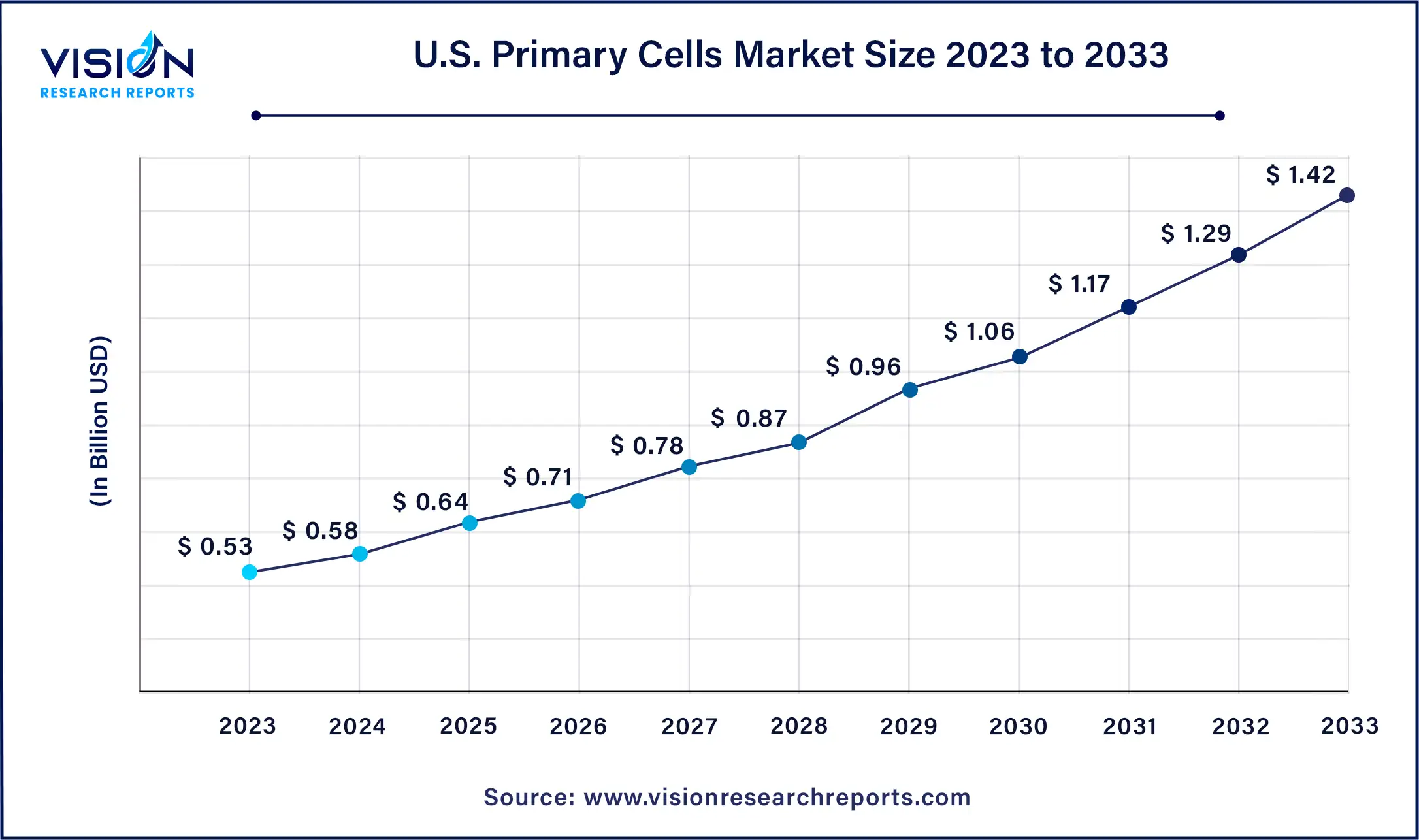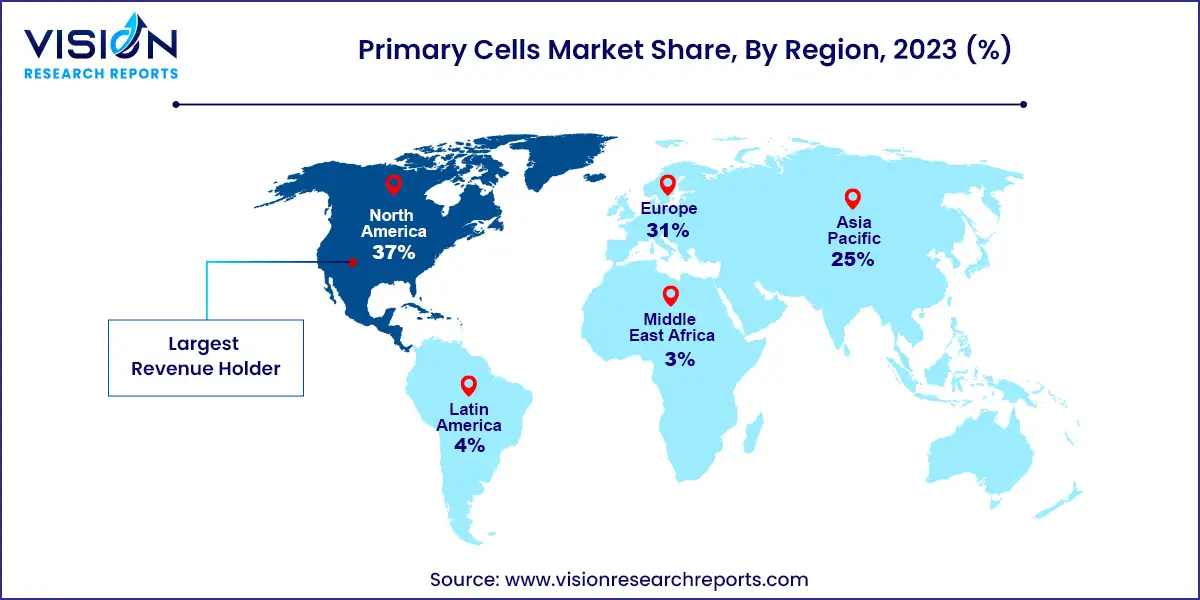The global primary cells market size was estimated at around USD 2.05 billion in 2023 and it is projected to hit around USD 5.52 billion by 2033, growing at a CAGR of 10.42% from 2024 to 2033.

The primary cells market is experiencing significant growth driven by an increasing demand for personalized medicine and advanced research in cell biology and regenerative medicine. Primary cells, which are directly isolated from human or animal tissues, offer more accurate biological responses compared to immortalized cell lines, making them invaluable for drug discovery, toxicity testing, and cancer research. The market is bolstered by advancements in cell isolation and culture technologies, rising investments in biopharmaceutical research, and the expanding focus on developing novel therapies.
The U.S. primary cells market size was estimated at USD 0.53 billion in 2023 and is expected to surpass around USD 1.42 billion by 2033, poised to grow at a CAGR of 10.42% from 2024 to 2033.

North America dominated the market with a 37% share in 2023 due to growing investments in cancer research and development. With numerous biotechnology and pharmaceutical companies in the region working on developing new therapies for cancer and chronic diseases, North America is expected to maintain its dominance over the forecast period.

The Asia Pacific region is anticipated to witness the fastest growth at a CAGR of 12.53% from 2024 to 2033. This growth is driven by increasing investments in healthcare infrastructure, rising cancer cases, and a growing focus on R&D activities related to cancer treatments and therapies.
The growth of the primary cells market is driven by several key factors, including the rising prevalence of chronic diseases, which necessitates advanced research for effective treatments. Additionally, the surge in personalized medicine emphasizes the need for biologically relevant cell models. Technological advancements in cell isolation and culture techniques have also made primary cells more accessible and viable for research purposes. Increased funding and investments in biopharmaceutical research further support market expansion. Moreover, the growing focus on regenerative medicine and the development of novel therapies are propelling the demand for primary cells, underscoring their critical role in modern medical research and development.
The human primary cells segment led the market with a 64% share in 2023. These cells are crucial for research and development (R&D) because they closely mimic the physiological state of cells in vivo, providing more biologically relevant data than immortalized cell lines. Their use in cell culture systems significantly enhances the physiological relevance of the generated data, enabling researchers to obtain insights that align more closely with in vivo outcomes. This segment is expected to grow at the fastest compound annual growth rate (CAGR) over the forecast period. Compared to immortalized cell lines, primary cells offer several advantages, such as maintaining key aspects of their tissue origin, representing donor variability, and generating predictive data.
Additionally, animal cells are essential for studying various biological processes and diseases in vitro. Primary cultures derived from animal tissues closely replicate the physiological state of cells in vivo, providing valuable insights into cellular functions. Animal primary cells are beneficial for physiological relevance, disease modeling, and research applications, and are widely used in fields such as cancer biology, drug development, toxicology studies, and regenerative medicine.
The pharmaceuticals and biotechnology companies segment experienced significant revenue growth in 2023. Primary cells are vital tools for these companies in drug discovery, disease modeling, toxicology studies, high-throughput screening projects, and personalized medicine initiatives. For example, in April 2023, AnaBios Corporation acquired Cell Systems, a leading U.S.-based human primary cell and cell culture media company. This acquisition is expected to significantly enhance AnaBios' portfolio of human tissues and cells, providing scientists with a broad array of biologically relevant tools to expedite drug discovery and deepen their understanding of cell biology.
Primary cells are also used to screen compounds for efficacy and safety profiles before clinical trials, and to assess new drugs' safety profiles by studying their effects on human tissues without solely relying on animal models. Their physiological relevance helps identify potential drug candidates with higher success rates.
The academic and research institutes segment is anticipated to grow at the fastest CAGR over the forecast period. In these settings, primary cells are essential for advancing scientific knowledge and understanding various biological processes. They offer a more accurate representation of in vivo cellular behavior than immortalized cell lines. These freshly isolated cells maintain their physiological properties and closely mimic the tissue microenvironment, providing valuable insights into cell function, disease mechanisms, drug responses, and therapeutic development.
The hematopoietic cells segment held the largest market share of 26% in 2023, due to their importance in regenerative medicine research and development. These multipotent primitive cells can develop into all types of blood cells, including myeloid and lymphoid lineage cells. Researchers are actively exploring the use of adult-derived hematopoietic stem cells (HSCs) in clinical and basic science applications due to their diverse feasibility and significance in stem cell biology. HSCs and their derived progenitors are crucial in regenerative medicine, offering potential treatments for various conditions, including non-hematopoietic tissue regeneration and blood disorders. Their ability to differentiate into diverse progenitors makes them valuable for developing effective therapeutic strategies.
The skeletal and muscle cells segment is expected to grow at the fastest CAGR over the forecast period due to their use in studying satellite cell function and regeneration mechanisms as potential therapeutic targets for muscular dystrophies. Researchers from King's College London and University College London recently published findings on a novel tool that uses images to identify optimal cells for implantation, potentially aiding in repairing damaged and diseased muscles.
The cancer research segment led the market with a 38% share in 2023. Primary cells are significant in oncology R&D due to their physiological relevance, genetic diversity, and representation of the tumor microenvironment, offering more accurate and reliable results than cell lines. This allows researchers to study disease mechanisms and drug responses and develop targeted therapies for various cancers. The advantages of primary human cells, such as their ability to closely represent signaling in vivo, make them essential in oncology research.
The regenerative medicine segment is expected to grow at the fastest CAGR over the forecast period. Human primary cells play a substantial role in regenerative medicine due to their ability to closely mimic the in vivo biology of cells. Isolated directly from human tissues, these cells provide a more reliable and relevant representation of human biology compared to immortalized cell lines. In October 2020, Astellas Pharma, a Japanese pharmaceutical company, opened its $120 million expanded Astellas Institute for Regenerative Medicine (AIRM) facility in Westborough, Massachusetts.
By Origin
By Type
By Application
By End-use
By Region
Chapter 1. Introduction
1.1. Research Objective
1.2. Scope of the Study
1.3. Definition
Chapter 2. Research Methodology
2.1. Research Approach
2.2. Data Sources
2.3. Assumptions & Limitations
Chapter 3. Executive Summary
3.1. Market Snapshot
Chapter 4. Market Variables and Scope
4.1. Introduction
4.2. Market Classification and Scope
4.3. Industry Value Chain Analysis
4.3.1. Raw Material Procurement Analysis
4.3.2. Sales and Distribution Channel Analysis
4.3.3. Downstream Buyer Analysis
Chapter 5. COVID 19 Impact on Primary Cells Market
5.1. COVID-19 Landscape: Primary Cells Industry Impact
5.2. COVID 19 - Impact Assessment for the Industry
5.3. COVID 19 Impact: Global Major Government Policy
5.4. Market Trends and Opportunities in the COVID-19 Landscape
Chapter 6. Market Dynamics Analysis and Trends
6.1. Market Dynamics
6.1.1. Market Drivers
6.1.2. Market Restraints
6.1.3. Market Opportunities
6.2. Porter’s Five Forces Analysis
6.2.1. Bargaining power of suppliers
6.2.2. Bargaining power of buyers
6.2.3. Threat of substitute
6.2.4. Threat of new entrants
6.2.5. Degree of competition
Chapter 7. Competitive Landscape
7.1.1. Company Market Share/Positioning Analysis
7.1.2. Key Strategies Adopted by Players
7.1.3. Vendor Landscape
7.1.3.1. List of Suppliers
7.1.3.2. List of Buyers
Chapter 8. Global Primary Cells Market, By Origin
8.1. Primary Cells Market, by Origin, 2024-2033
8.1.1. Human Primary Cells
8.1.1.1. Market Revenue and Forecast (2021-2033)
8.1.2. Animal Primary Cells
8.1.2.1. Market Revenue and Forecast (2021-2033)
Chapter 9. Global Primary Cells Market, By Type
9.1. Primary Cells Market, by Type, 2024-2033
9.1.1. Hematopoietic Cells
9.1.1.1. Market Revenue and Forecast (2021-2033)
9.1.2. Skin Cells
9.1.2.1. Market Revenue and Forecast (2021-2033)
9.1.3. Hepatocytes
9.1.3.1. Market Revenue and Forecast (2021-2033)
9.1.4. Gastrointestinal Cells
9.1.4.1. Market Revenue and Forecast (2021-2033)
9.1.5. Lung Cells
9.1.5.1. Market Revenue and Forecast (2021-2033)
9.1.6. Renal Cells
9.1.6.1. Market Revenue and Forecast (2021-2033)
9.1.7. Heart Cells
9.1.7.1. Market Revenue and Forecast (2021-2033)
9.1.8. Skeletal and Muscle Cells
9.1.8.1. Market Revenue and Forecast (2021-2033)
9.1.9. Other Primary Cells
9.1.9.1. Market Revenue and Forecast (2021-2033)
Chapter 10. Global Primary Cells Market, By Application
10.1. Primary Cells Market, by Application, 2024-2033
10.1.1. Drug Discovery and Development
10.1.1.1. Market Revenue and Forecast (2021-2033)
10.1.2. Regenerative Medicine
10.1.2.1. Market Revenue and Forecast (2021-2033)
10.1.3. Cancer Research
10.1.3.1. Market Revenue and Forecast (2021-2033)
10.1.4. Others
10.1.4.1. Market Revenue and Forecast (2021-2033)
Chapter 11. Global Primary Cells Market, By End-use
11.1. Primary Cells Market, by End-use, 2024-2033
11.1.1. Pharmaceuticals & Biotechnology Companies
11.1.1.1. Market Revenue and Forecast (2021-2033)
11.1.2. Academic & Research Institutes
11.1.2.1. Market Revenue and Forecast (2021-2033)
11.1.3. CROs
11.1.3.1. Market Revenue and Forecast (2021-2033)
Chapter 12. Global Primary Cells Market, Regional Estimates and Trend Forecast
12.1. North America
12.1.1. Market Revenue and Forecast, by Origin (2021-2033)
12.1.2. Market Revenue and Forecast, by Type (2021-2033)
12.1.3. Market Revenue and Forecast, by Application (2021-2033)
12.1.4. Market Revenue and Forecast, by End-use (2021-2033)
12.1.5. U.S.
12.1.5.1. Market Revenue and Forecast, by Origin (2021-2033)
12.1.5.2. Market Revenue and Forecast, by Type (2021-2033)
12.1.5.3. Market Revenue and Forecast, by Application (2021-2033)
12.1.5.4. Market Revenue and Forecast, by End-use (2021-2033)
12.1.6. Rest of North America
12.1.6.1. Market Revenue and Forecast, by Origin (2021-2033)
12.1.6.2. Market Revenue and Forecast, by Type (2021-2033)
12.1.6.3. Market Revenue and Forecast, by Application (2021-2033)
12.1.6.4. Market Revenue and Forecast, by End-use (2021-2033)
12.2. Europe
12.2.1. Market Revenue and Forecast, by Origin (2021-2033)
12.2.2. Market Revenue and Forecast, by Type (2021-2033)
12.2.3. Market Revenue and Forecast, by Application (2021-2033)
12.2.4. Market Revenue and Forecast, by End-use (2021-2033)
12.2.5. UK
12.2.5.1. Market Revenue and Forecast, by Origin (2021-2033)
12.2.5.2. Market Revenue and Forecast, by Type (2021-2033)
12.2.5.3. Market Revenue and Forecast, by Application (2021-2033)
12.2.5.4. Market Revenue and Forecast, by End-use (2021-2033)
12.2.6. Germany
12.2.6.1. Market Revenue and Forecast, by Origin (2021-2033)
12.2.6.2. Market Revenue and Forecast, by Type (2021-2033)
12.2.6.3. Market Revenue and Forecast, by Application (2021-2033)
12.2.6.4. Market Revenue and Forecast, by End-use (2021-2033)
12.2.7. France
12.2.7.1. Market Revenue and Forecast, by Origin (2021-2033)
12.2.7.2. Market Revenue and Forecast, by Type (2021-2033)
12.2.7.3. Market Revenue and Forecast, by Application (2021-2033)
12.2.7.4. Market Revenue and Forecast, by End-use (2021-2033)
12.2.8. Rest of Europe
12.2.8.1. Market Revenue and Forecast, by Origin (2021-2033)
12.2.8.2. Market Revenue and Forecast, by Type (2021-2033)
12.2.8.3. Market Revenue and Forecast, by Application (2021-2033)
12.2.8.4. Market Revenue and Forecast, by End-use (2021-2033)
12.3. APAC
12.3.1. Market Revenue and Forecast, by Origin (2021-2033)
12.3.2. Market Revenue and Forecast, by Type (2021-2033)
12.3.3. Market Revenue and Forecast, by Application (2021-2033)
12.3.4. Market Revenue and Forecast, by End-use (2021-2033)
12.3.5. India
12.3.5.1. Market Revenue and Forecast, by Origin (2021-2033)
12.3.5.2. Market Revenue and Forecast, by Type (2021-2033)
12.3.5.3. Market Revenue and Forecast, by Application (2021-2033)
12.3.5.4. Market Revenue and Forecast, by End-use (2021-2033)
12.3.6. China
12.3.6.1. Market Revenue and Forecast, by Origin (2021-2033)
12.3.6.2. Market Revenue and Forecast, by Type (2021-2033)
12.3.6.3. Market Revenue and Forecast, by Application (2021-2033)
12.3.6.4. Market Revenue and Forecast, by End-use (2021-2033)
12.3.7. Japan
12.3.7.1. Market Revenue and Forecast, by Origin (2021-2033)
12.3.7.2. Market Revenue and Forecast, by Type (2021-2033)
12.3.7.3. Market Revenue and Forecast, by Application (2021-2033)
12.3.7.4. Market Revenue and Forecast, by End-use (2021-2033)
12.3.8. Rest of APAC
12.3.8.1. Market Revenue and Forecast, by Origin (2021-2033)
12.3.8.2. Market Revenue and Forecast, by Type (2021-2033)
12.3.8.3. Market Revenue and Forecast, by Application (2021-2033)
12.3.8.4. Market Revenue and Forecast, by End-use (2021-2033)
12.4. MEA
12.4.1. Market Revenue and Forecast, by Origin (2021-2033)
12.4.2. Market Revenue and Forecast, by Type (2021-2033)
12.4.3. Market Revenue and Forecast, by Application (2021-2033)
12.4.4. Market Revenue and Forecast, by End-use (2021-2033)
12.4.5. GCC
12.4.5.1. Market Revenue and Forecast, by Origin (2021-2033)
12.4.5.2. Market Revenue and Forecast, by Type (2021-2033)
12.4.5.3. Market Revenue and Forecast, by Application (2021-2033)
12.4.5.4. Market Revenue and Forecast, by End-use (2021-2033)
12.4.6. North Africa
12.4.6.1. Market Revenue and Forecast, by Origin (2021-2033)
12.4.6.2. Market Revenue and Forecast, by Type (2021-2033)
12.4.6.3. Market Revenue and Forecast, by Application (2021-2033)
12.4.6.4. Market Revenue and Forecast, by End-use (2021-2033)
12.4.7. South Africa
12.4.7.1. Market Revenue and Forecast, by Origin (2021-2033)
12.4.7.2. Market Revenue and Forecast, by Type (2021-2033)
12.4.7.3. Market Revenue and Forecast, by Application (2021-2033)
12.4.7.4. Market Revenue and Forecast, by End-use (2021-2033)
12.4.8. Rest of MEA
12.4.8.1. Market Revenue and Forecast, by Origin (2021-2033)
12.4.8.2. Market Revenue and Forecast, by Type (2021-2033)
12.4.8.3. Market Revenue and Forecast, by Application (2021-2033)
12.4.8.4. Market Revenue and Forecast, by End-use (2021-2033)
12.5. Latin America
12.5.1. Market Revenue and Forecast, by Origin (2021-2033)
12.5.2. Market Revenue and Forecast, by Type (2021-2033)
12.5.3. Market Revenue and Forecast, by Application (2021-2033)
12.5.4. Market Revenue and Forecast, by End-use (2021-2033)
12.5.5. Brazil
12.5.5.1. Market Revenue and Forecast, by Origin (2021-2033)
12.5.5.2. Market Revenue and Forecast, by Type (2021-2033)
12.5.5.3. Market Revenue and Forecast, by Application (2021-2033)
12.5.5.4. Market Revenue and Forecast, by End-use (2021-2033)
12.5.6. Rest of LATAM
12.5.6.1. Market Revenue and Forecast, by Origin (2021-2033)
12.5.6.2. Market Revenue and Forecast, by Type (2021-2033)
12.5.6.3. Market Revenue and Forecast, by Application (2021-2033)
12.5.6.4. Market Revenue and Forecast, by End-use (2021-2033)
Chapter 13. Company Profiles
13.1. Thermo Fisher Scientific
13.1.1. Company Overview
13.1.2. Product Offerings
13.1.3. Financial Performance
13.1.4. Recent Initiatives
13.2. Merck KGaA
13.2.1. Company Overview
13.2.2. Product Offerings
13.2.3. Financial Performance
13.2.4. Recent Initiatives
13.3. Lonza
13.3.1. Company Overview
13.3.2. Product Offerings
13.3.3. Financial Performance
13.3.4. Recent Initiatives
13.4. Cell Biologics, Inc.
13.4.1. Company Overview
13.4.2. Product Offerings
13.4.3. Financial Performance
13.4.4. Recent Initiatives
13.5. PromoCell
13.5.1. Company Overview
13.5.2. Product Offerings
13.5.3. Financial Performance
13.5.4. Recent Initiatives
13.6. ZenBio
13.6.1. Company Overview
13.6.2. Product Offerings
13.6.3. Financial Performance
13.6.4. Recent Initiatives
13.7. STEMCELL Technologies
13.7.1. Company Overview
13.7.2. Product Offerings
13.7.3. Financial Performance
13.7.4. Recent Initiatives
13.8. AllCells
13.8.1. Company Overview
13.8.2. Product Offerings
13.8.3. Financial Performance
13.8.4. Recent Initiatives
13.9. American Type Culture Collection
13.9.1. Company Overview
13.9.2. Product Offerings
13.9.3. Financial Performance
13.9.4. Recent Initiatives
13.10. Axol Biosciences Ltd.
13.10.1. Company Overview
13.10.2. Product Offerings
13.10.3. Financial Performance
13.10.4. Recent Initiatives
Chapter 14. Research Methodology
14.1. Primary Research
14.2. Secondary Research
14.3. Assumptions
Chapter 15. Appendix
15.1. About Us
15.2. Glossary of Terms
 Cross-segment Market Size and Analysis for
Mentioned Segments
Cross-segment Market Size and Analysis for
Mentioned Segments
 Additional Company Profiles (Upto 5 With No Cost)
Additional Company Profiles (Upto 5 With No Cost)
 Additional Countries (Apart From Mentioned Countries)
Additional Countries (Apart From Mentioned Countries)
 Country/Region-specific Report
Country/Region-specific Report
 Go To Market Strategy
Go To Market Strategy
 Region Specific Market Dynamics
Region Specific Market Dynamics Region Level Market Share
Region Level Market Share Import Export Analysis
Import Export Analysis Production Analysis
Production Analysis Others
Others